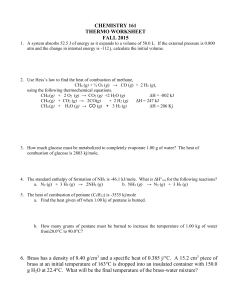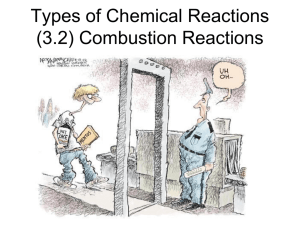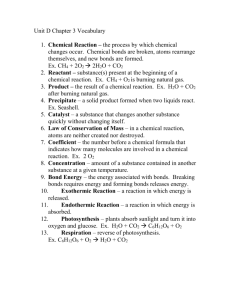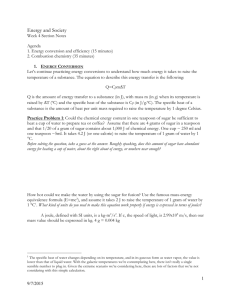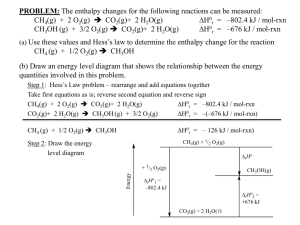thermochemistry - Pianeta Scuola Gallery
advertisement
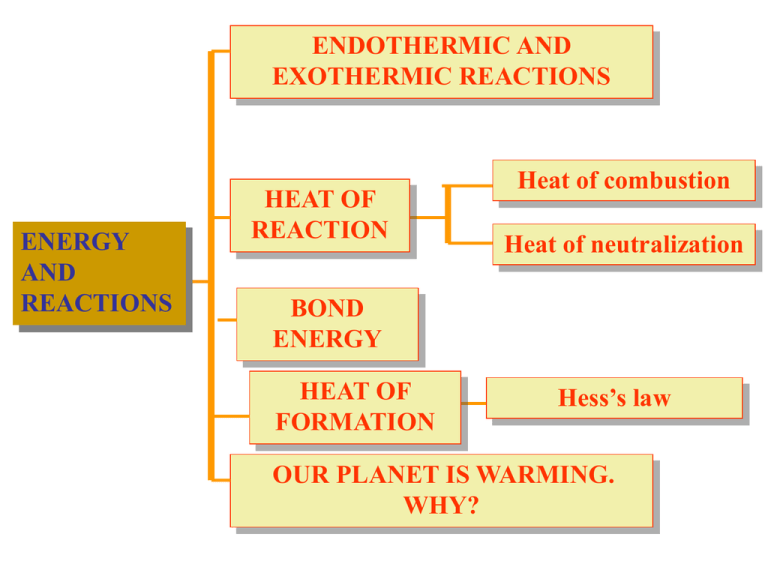
ENDOTHERMIC AND EXOTHERMIC REACTIONS ENERGY AND REACTIONS HEAT OF REACTION Heat of combustion Heat of neutralization BOND ENERGY HEAT OF FORMATION Hess’s law OUR PLANET IS WARMING. WHY? EXOTHERMIC AND ENDOTHERMIC REACTIONS The study of the heat changes that accompany chemical reactions is called thermochemistry Burning fuels in air always produces heat, “burning” food inside our bodies supplies us with the energy we need Combustion of methane is one example of a reaction that produces heat Any chemical reaction that produces heat is called an exothermic reaction EXOTHERMIC AND ENDOTHERMIC REACTIONS We note a drop in temperature if we hold a beaker of water at room temperature and add some ammonium chloride (NH4Cl) to it: in this case heat is taken in from the hand. NH4Cl Any chemical reaction that takes in heat from the surroundings is called an endothermic reaction HEAT OF REACTION Hydrogen is a fuel which burns in oxygen to form water: H2(g) + ½ O2(g) H2O(g) D H = - 242 kJ The symbol D H (delta H) indicates the variation of hentalpy: the heat change taking place when a chemical reaction occurs at a constant pressure and a constant temperature. This equation states that when one mole of hydrogen reacts with half a mole of oxygen to form one mole of steam 242 kJ of heat are released. A negative value of D H indicates an exothermic reaction A positive value of D H indicates an endothermic reaction The D H value above is referred to as the molar heat of reaction. If the number of moles in the balanced equation are changed, then the heat of reaction also changes: 2 H2(g) + O2(g) 2H2O(g) D H = - 484 kJ Heat of reaction is the heat change when the moles of reactants, indicated in the balanced equation, react completely. HEAT OF COMBUSTION A reaction in which a substance is burned is called a combustion reaction. Consider the reaction in which carbon is burned in oxygen to form carbon dioxide : C(s) + O2(g) CO2(g) D H = - 393 kJ The heat given out in the reaction is called the heat of combustion. Heat of combustion of a substance is the heat change when one mole of the substance is completely burned in excess oxygen. HEAT OF COMBUSTION • The phrase “is completely burned in excess oxygen” means that the product of reaction must be carbon dioxide and not carbon monoxide as it occurs in an incomplete combustion: C(s) + ½ O2(g) CO(g) D H = - 111 kJ The value of D H is not the heat of combustion of carbon. • Another important phrase is “one mole”. Consider the thermochemical reaction in which butane is burned: 2 C4H10(g) + 13 O2(g) kJ 8CO2(g) + 10H2O(g) D H = - 5720 The heat of combustion of butane is not - 5720 kJ, In fact the heat of combustion involves one mole of butane being burned; therefore the correct value is –5720/2 = -2860 kJ mol-1 HEAT OF COMBUSTION Heat of combustion is accurately measured using a bomb calorimeter. This instrument consists of a steel container (the bomb), with a screw-on cap. The sample whose heat of combustion is to be measured is placed in a crucible inside the bomb. The bomb is placed in a container of water (the calorimeter), oxygen is pumped inside and the sample is ignited by electric wires. By measuring the increase in temperature of the water it is possible to measure the heat of combustion of the fuel. HEAT OF COMBUSTION In some cases, in industry, chemists measure the heat given out by a fuel (or food) in terms of the mass of fuel rather than one mole of substance, in order to compare the efficiency of various fuels and to state if the fuel is of good quality. For example, if you read the side of a box of cornflakes, you will find that 100g of cornflakes provides about 1550 kJ of energy. Chemists use the term: kilogram calorific value. The kilogram calorific value of a fuel is the heat, the energy, produced when 1 kg of the fuel is completely burned in oxygen. HEAT OF COMBUSTION Some examples of the heat of combustion of various fuels Fuel D H (kJ mol-1) at 25 °C Kilogram caloric value (kJ kg-1) Formula Heat of combustion Methane CH4(g) -890 55.625 Ethane Propane Butane Hexane C2H6(g) -1560 52.000 C3H8(g) -2230 50.454 C4H10(g) -2877 49.603 C6H14(l) -4194 48.767 Ethanol C2H5OH(l) -1371 29.804 Carbon Hydrogen C (g) -393 32.750 H2(g) -286 143.000 HEAT OF NEUTRALISATION Neutralisation: a reaction between an acid and a base to form a salt and water: HCl + NaOH NaCl + H2O Strong acids, strong bases and salts are fully dissociated in water, thus the essential reaction taking place ingnores spectator ions Na+ and Cl-: H+ + Cl- + Na+ + OHH+ + OH- Na+ + Cl- + H2O H2O D H = - 57.1 kJ Neutralisation reactions are nearly always exothermic. The heat of neutralisation is the heat change when one mole of H+ ions from an acid reacts with one mole of OH- ions from a base. The heat of reaction in a reaction of neutralisation depends on the numbers of moles of water formed, therefore the heat of reaction between sulphuric acid and sodium hydroxide is double since two moles of water are formed: H2SO4 + 2NaOH Na2SO4 + 2H2O D H = - 2 · 57 kJ = - 114 kJ BOND ENERGY What determines the value of D H for a particular reaction? Consider the combustion of methane: CH4(s) + 2O2(g) CO2(g) + 2H2O(g) As known, when a chemical reaction occurs, the bonds of reactants are broken and the bonds of products are formed. Energy is required to break bonds and energy is released when bonds are formed. D H = - 890 kJ Reactants Products Energy absorbed to break bonds of reactants. Energy released when bonds of products are formed. The bond energy is the energy required to break one mole of covalent bonds and to separate the neutral atom completely from each other (the same amount of energy is released when one mole of bonds is formed). BOND ENERGY Let us consider the energy required to break 4 C – H bonds and the energy required to break the two double bonds in the oxygen molecules; these values (table to the right) are considered positives: + 4 · 412 kJ = + 1648 kJ required + 2 · 496 kJ =+ 992 kJ required Below are the values of the energy released (negative values) when the bonds of products are formed: - 2 · 743 kJ = - 1486 kJ released - 4 · 463 kJ = - 1852kJ released Bond Bond energy ( kJ mol-1) C-H 412 C-C 348 C=C 612 O–H 463 O=O 496 C=O 743 BOND ENERGY The D H for the combustion of methane is obtained making the sum of energy required to break bonds of reactants and the energy released when bonds of products are formed: REACTANTS + 4 · 412 kJ = + 1648 kJ required ENERGY + + 2 · 496 kJ = + 992 kJ required + PRODUCTS ENERGY - 2 · 743 kJ = - 1486 kJ released + - 4 · 463 kJ = - 1852kJ released D H = - 698kJ HEAT OF FORMATION The heat of formation of a compound is the heat change that takes place when one mole of a compound, in its standard state, is formed from its elements in their standard states. The standard state of an element or compound is its normal form at 25 °C at one atmosphere pressure (101 kPa) The heat of formation of water is – 285.8 kJ / mol and may be represented as: H2(g) + ½ O2(g) H2O(l) D H = - 285.8 kJ / mol The following equation does not represent the heat of formation of water: H2(g) + ½ O2(g) H2O(g) D H = - 241.8 kJ / mol The reason is because the water formed in the above reaction is in the gaseous state. At 25 °C the normal state of water is a liquid. HEAT OF FORMATION The heat of formation of any element in its standard state is zero. The heats of formation of most compounds have negative value of D H: energy is given out when the compound is formed from its elements. The more negative the value of the heat of formation is, the more stable is the compound. Substance Formula Normal state at 25 °C CH4 Heat of formaton D H (kJ mol-1) - 74.9 Methane Ethane C2H6 - 84. 7 gas Carbon monoxide CO - 111 gas Carbon dioxide CO2 - 393 gas Ammonia NH3 - 46.2 gas Ethanol C2H5OH - 278 liquid Iron Fe 0 solid Oxygen O2 0 gas gas HESS’S LAW Hess’s law states that if a chemical reaction takes place in a number of stages, the sum of the heat changes in the separate stages, is equal to the heat change when the reaction is carried out in one stage. In other words, the amount of energy liberated or absorbed in a chemical reaction is the same whether the reaction takes place in one o several steps, as shown below: A B C D D HA D = D HA B + D HB C + D HC D HESS’S LAW Consider the two routes for converting carbon and oxygen to carbon dioxide C +1/2 O2 D H2 = ? CO + O2 D H 1 = - 394 kJ mol -1 C O2 HESS’S LAW Hess’s law may be used to calculate the unknown heat of the reaction that converts carbon to carbon monoxide: C + 1/2 O2 CO C +1/2 O2 + O2 D H 1 = - 394 kJ mol -1 C O2 D H2 = ? CO D H1=D H2+D H3 C(s) + 1/2 O2(g) - 394 = x - 283 CO(g) x = - 394 + 283 = -111 kJ mol-1 D H 2 = - 111 kJ mol-1 HESS’S LAW Hess’s Law is useful because: • the value of the heat of reaction can be calculated indirectly, if it proves difficult to find it directly in the laboratory. (It is difficult to measure the heat of formation of CO since some CO2 is also formed during the experiment). • thermochemical reactions can be added (+), subtracted (-), multiplied (x) or divided (:) to calculate unknown heat of reaction. HESS’S LAW Calculate the heat of formation of CH4 from the following heats of combustion: a) C(s) + O2(g) b) H2(g) + 1/2 O2(g) c) CH4(g) + 2 O2(g) CO2 (g) H2O (g) CO2 (g) + 2 H2O (g) D H = - 393 kJ mol -1 D H = - 286 kJ mol -1 D H = - 879 kJ mol -1 We need to write the balanced equation of formation of methane from his elements: C(s) + 2 H2(g) CH4 (g) D H=? HESS’S LAW We must build up the reaction of formation of methane using the above mentioned thermochemical reactions. Introduce C a) C(s) + O2(g) D H = - 393 kJ mol -1 CO2 (g) Introduce 2 H2. Multiply equation b) by 2. Do not forget to multiply D H by 2 as well. b) x 2 : 2 H2(g) + O2(g) 2 H2O (g) D H = - 572 kJ mol -1 HESS’S LAW Get the left-hand side of the required equation by adding the following equations: a) C(s) + O2(g) CO2 (g) D H = - 393 kJ mol - 2 H2(g) + O2(g) 2 H2O (g) D H = - 572 kJ mol - 1 b) x 2 : 1 d) C(s) + 2 H2(g) + 2 O2(g) CO2 (g) + 2 H2O (g) D H = - 965 kJ mol -1 HESS’S LAW Introduce CH4 We have CH4 on the left-hand side of equation c). We need it on the right-hand side of the equation for the formation of methane. Reverse equation c), remembering to reverse the sign of D H too c) reversed CO2 (g) + 2 H2O (g) 1 CH4(g) + 2 O2(g) D H = + 879 kJ mol - HESS’S LAW Now add c) reversed to d) equation: d) 1 C(s) + 2 H2(g) + 2 O2(g) c) reversed CO2 (g) + 2 H2O (g) CO2 (g) + 2 H2O (g) D H = - 965 kJ mol CH4(g) + 2 O2(g) C(s) + 2 H2(g)+ 2 O2(g)+CO2 (g)+ 2 H2O (g) O2(g) D H = +879 kJ mol -1 CO2 (g)+ 2 H2O (g) + CH4(g) + 2 We obtain the required equation of formation of methane: C(s) + 2 H2(g) CH4 (g) -1 -1 STUDENT EXPERIMENT Calculate the heat liberated using the equation: Heat liberated = (ms + me) · c · (t2 – t1) ms= mass of solution in kg me = mass equivalent in water of the calorimeter that absorbs heat (about 30 g) c= specific heat capacity of solution in J kg-1 K-1 (assume 4060 J kg-1 K-1 for the solution) t2 – t1 = temperature rise Note: Assume that the density of the solution is 1 g / cm 3 Calculate the heat of neutralisation Knowing the heat liberated when this number of moles of acid was neutralized, you can now calculate the amount of heat liberated when one mole of the acid is neutralized. STUDENT EXPERIMENT Experiment To determine the heat of reaction (heat of neutralisation) of hydrochloric acid with sodium hydroxide. Introduction In this experiment , an equal number of moles of hydrocloric acid are mixed with an equal number of moles of sodium hydroxide in a calorimeter. The rise in temperature is then measured and from this the heat of neutralization is calculated. Apparatus required Thermometer (reading to 0.1 °C), two beakers (100 ml), a calorimeter (250 ml), two burettes (50 ml). Chemicals required Hydrochloric acid (1.0 M), sodium hydroxide (1.0 M). STUDENT EXPERIMENT Procedure • Using a burette, place 50 ml of the 1 M hydrochloric acid solution into the first beaker. • Using the second burette, place 50 ml of the 1 M solution of sodium hydroxide into the second beaker. • Measure separately the temperature of the two solutions. • When the two solutions are at the same temperature, place the acid into the calorimeter and quickly add the base to the acid, stirring well. • Place the lid on the calorimeter, to prevent heat loss, and record the maximum temperature reached. STUDENT EXPERIMENT Summarize results as follows: Temperature of HCl before mixing = °C Temperature of NaOH before mixing = °C Highest temperature reached after mixing = °C Temperature rise = °C Number of moles of acid used = mol Number of moles of base used = mol Mass of solution = Kg CLIMATE CHANGE Why is the planet warming? • Huge amounts of energy are needed for heating, generating electricity and for transport. • Fuels give off numerous emissions that many say are bringing about great climate changes, because of the greenhouse effect of global warming. • All economic activity that requires energy consumption contributes to these emissions producing greenhouse gases. CLIMATE CHANGE Who and what contributes to greenhouse gases? Transport: CO2 emissions come from fuel combustion. Agriculture: is the largest producer of CH4. Industry: mainly contributes to greenhouse gas emissions through energy use, including direct consumption of fossil fuels and use of electricity (e.g. CO2 is a by-product of cement manufacture). Industry also produces some CFC’s although they, along with substances that were attacking the ozone layer, were banned by the Montreal Protocol in 1989. Energy: is the largest source of CO2 – mainly emissions from fossil fuel combustion to produce electricity. CLIMATE CHANGE Why are greenhouse gases dangerous for the environment? Greenhouse gas … … is a gas in the atmosphere that freely allows radiation from the sun to reach the earth’s surface, but traps the heat radiated back from the earth’s surface towards space. The heating effect is analogous to the manner in which the glass of a greenhouse traps the sun’s radiation to warm the air inside the greenhouse. CLIMATE CHANGE Greenhouse gas Sun’s radiation CO2 freely allows radiation from the sun, but traps heat radiated back from the earth’s surface. Heat Vegetation subtracts CO2 from the atmosphere, reducing damage by greenhouse gases. CLIMATE CHANGE Solutions? Hydrogen has the best potential of becoming the fuel of the future. Hydrogen can be produced from sustainable, renewable sources and may contribute to meeting the growth in world energy demand. Hydrogen is a carbon-free energy carrier. When used in fuel cells, there are no harmful emissions. The use of energy may lead to climate changes. It is thus necessary to make the transition to cleaner and environmentally favourable energy carriers.
